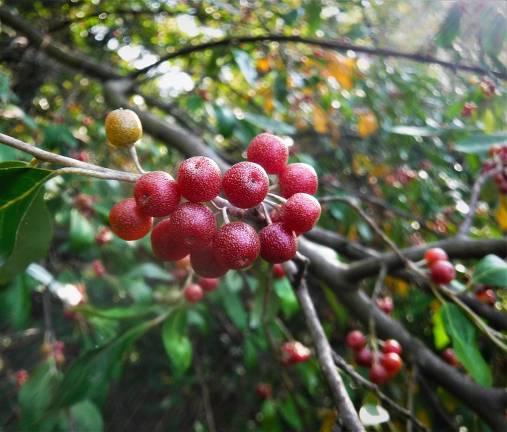The invader with a sweet side


Berries, berries everywhere. Raspberries and blackberries, huckleberries and blueberries weigh heavy on cane and twig, however by late summer, a lesser-known berry also ripens: autumn olive.
Autumn olive (Eleagnus umbellate) is neither an olive nor waits until autumn to produce fruit. This non-native, highly invasive shrub, once touted as a protective measure against soil erosion, lines our roadways and overtakes forgotten fields. Shrubs mature into small trees, often armed with large spines, and readily sprout new shoots. Although troublesome, autumn olive is undoubtedly attractive. Twigs and undersides of leaves are brushed with silver. After a fragrant flush of yellow flowers, the shrub produces scarlet fruits speckled silver too. We can uproot her, burn her and haul her away, but truth is she’s here to stay. So why not enjoy her? When life gives you autumn olives... eat them.
Autumn olive’s small one-seeded fruits, commonly called berries, are some of the tastiest wild fruits around. Harvest them straight from the shrub and pop in your mouth for a tart treat. That single seed is nutritious – rich in Omega-3 – but also fibrous, so you may choose to spit it like a cherry pit. The berries’ red hue speaks to their lycopene content, an antioxidant also found in tomatoes that may protect against degenerative diseases, but autumn olive berries boast 17 times more.
Autumn olive sauce is delectable. But you’ll have to harvest a lot of berries. Test a few first to ensure they are ripe. If they taste so astringent that your mouth turns to sandpaper, wait a little longer. Frost sweetens them but wait that long and the birds might beat you to them. If necessary, freeze berries for a time before working with them to mimic a cold snap.
Bring your berries to the stovetop. Add a little water and simmer berries until the pulp begins to separate from seed. Press pulp through a ricer or food mill to remove seeds, then transfer back to your pot, lightly warm and add sugar or honey to taste. Your finished product will be scarlet and smooth. Blend into desserts or drizzle atop yogurt and fresh fruit to savor a taste of summer.